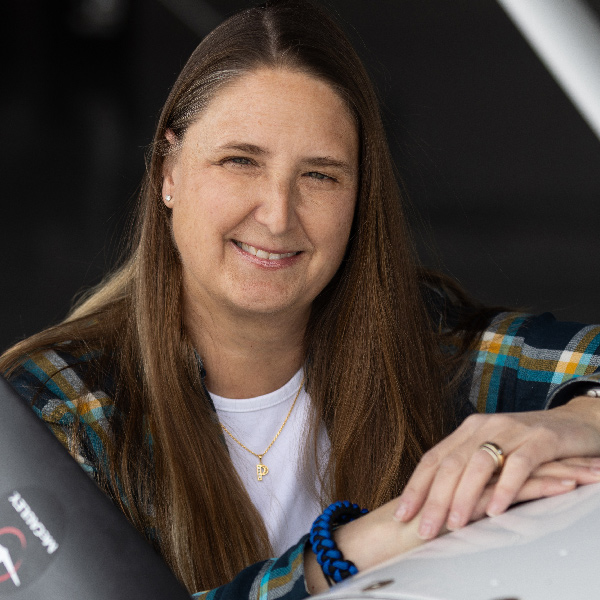Bizjet of tomorrow?
Otto Aerospace designs fuel-efficient Phantom 3500

“We’re really excited to get this airplane into the market,” Touw said at this year’s Paris Air Show, where Otto introduced itself to the world.
The differentiating highlight? A futuristic teardrop curvature shape that maximizes laminar flow across the entire airframe, not just the wing.
“Almost all aircraft have been designed in turbulent flow,” Touw says. “We are building a new type of aircraft, designed to take advantage of a revolutionary aerodynamic technology called laminar flow and as a result, it dramatically reduces fuel consumption, by 60 percent.”
Laminar flow is a type of fluid motion where a fluid travels smoothly and predictably in parallel layers, with minimal mixing. Turbulent flow, on the other hand, is characterized by irregular fluctuations, swirling motion, and mixing.
The Phantom 3500’s ultra-low-drag futuristic shape is optimized to maintain that laminar flow. The company has been testing its materials for more than 10 years. It began flight testing a demonstrator in 2017.
“It takes entirely new carbon fiber manufacturing processes that are very precise, to the thousands of an inch, in order to be able to manufacture an airplane to maintain laminar flow,” he adds.
The aircraft will seat nine passengers and is expected to have a range of 3,500 nautical miles. Its normal cruise altitude will be about 51,000 feet and top speed will be Mach 0.8. The airplane’s first flight is scheduled for 2027, with the company targeting certification “at the end of 2029” and the sale of its first units the following year.
Sustainability is a central argument for this aircraft, with Otto touting massively reduced emissions that could enable net-zero carbon emissions 20 years before the industry’s self-imposed goal.
“There are really two components to global warming forces produced by aviation: One is carbon dioxide, the second is formation of induced clouds by aircraft, or otherwise known as contrails,” Touw says. “Because of the altitude we fly at, we produce no contrails. And then, because our fuel consumption is so much lower, you can actually afford to put sustainable aviation fuel (SAF) in our aircraft.”
In addition, Otto says smaller and lighter aircraft systems make for sticker prices and maintenance costs lower than the aircraft’s traditional competitors, such as the Bombardier Challenger 3500 or the Cessna Latitude and Longitude, require. The company is targeting the super-mid sector, which Touw calls “the sweet spot of the business aviation market.”
“It is the sort of intercontinental, intracontinental aircraft, or coast to coast and it can also go over to Europe.”
Phantom 3500’s propulsion will come from the Williams International FJ44 engine, a popular choice on light jets, also powering Pilatus’ PC–24 and several Cessna Citation models. In August, Otto said Italian aerospace company Secondo Mona will build the integrated fuel system. Many of the components that Otto will integrate into the aircraft are off-the-shelf, in order to streamline the certification process.
“A lot of our avionics are already certified, our landing gear is a derivative of another landing gear, our environmental systems and deicing and flight control systems are already certified. They will all have to be recertified on our aircraft, but you have a huge leg up when you’re using commercial off the shelf systems,” he says. “We did that on purpose because the one miracle on our project is the outer mold line, the outer shape of the aircraft. And we want to get through certification with that. We want everything else to kind of be a cakewalk.”
If the outside of the aircraft looks unusual, the interior is even more so.
“It’s not your typical tube style fuselage, and that is to maximize the effect of laminar flow,” he says. At its largest point, cabin height will be 6 feet 5 inches, larger than a Gulfstream 650. And it has no windows.
“We have lots of cameras around the aircraft that are piping in very high-fidelity digital images into an internal graphics processing system that then displays the outer world on displays inside the aircraft,” he says. “So, you actually get a much more vivid view of the outside world with much larger screens, a much cleaner, more beautiful and highly optimized and stabilized image which also doesn’t convey the glare of the sun.”
When the aircraft flies during darkness, the panorama screens will automatically show a synthetic image created by an augmented reality system.
“Of course, we can use all those displays for other purposes, too, like Zoom calls or streaming services like Netflix or Hulu.”
Otto made waves at this year’s summer airshow, as it announced a financial package from the state of Florida to build its manufacturing facility and headquarters at Cecil Airport (VQQ), southwest of Jacksonville.
“We obtained an incredible incentive package worth about $515 million, we have 250 acres that they have given us on Cecil airfield, so we are very excited about that we’ll be building our production facility there,” Touw says.
The facility, which will be the primary site for final assembly of the Phantom 3500, will break ground in 2026 and eventually create almost 400 jobs. The company aims to build 1,600 aircraft between 2030 and 2040, and “roughly a third of those are already spoken for.” In late September, Otto announced that fractional jet operator Flexjet will be its first fleet customer, with an order of 300 airframes.
“I think once people see the performance gains you get out of this, all aircraft over the next 70 years are going to be built this way. We’re obviously going to be using this technology going forward, but like electric cars, we think other manufacturers will follow suit.” 



